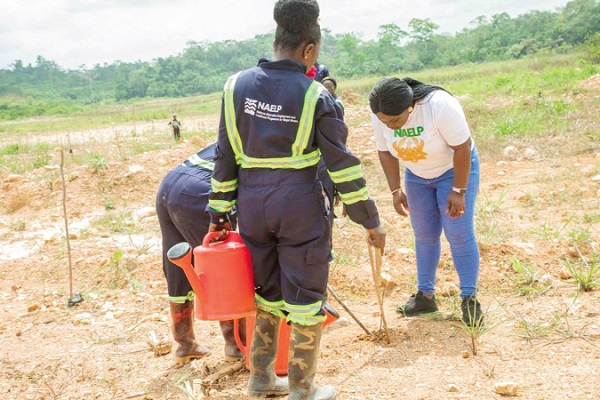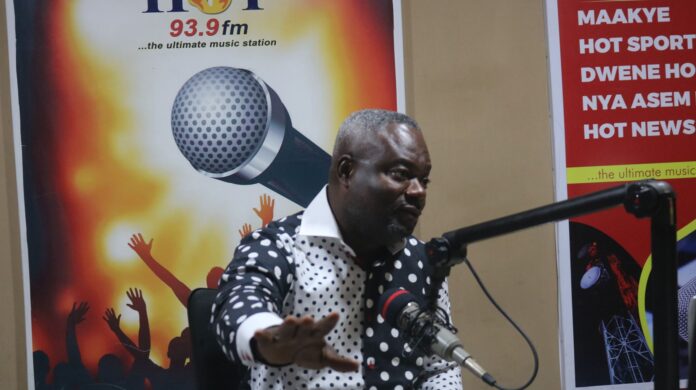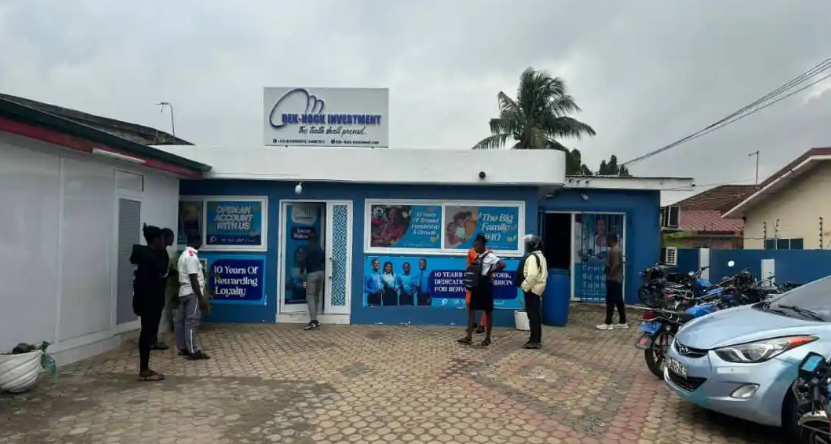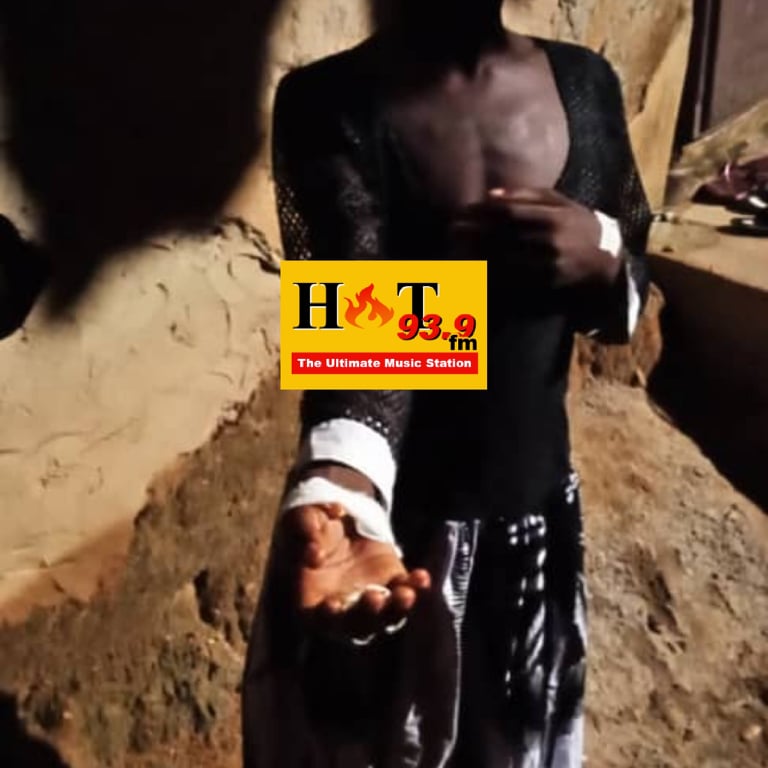The national land reclamation project rolled out by the government to restore lands degraded by illegal mining activities is receiving an endorsement from residents of mining communities.
The project, which is part of the National Alternative Employment and Livelihood Programme (NAELP) under the Ministry of Lands and Natural Resources, is targeted mainly at degraded lands that straddle water bodies, with the ultimate aim of restoring the lands, while breathing a new lease of life into rivers.
Adopting community participation, the reclamation project started in the last quarter of last year, with 1,000 hectares of degraded lands being reclaimed.
Six months into the project, the chiefs and residents of mining areas in the Ashanti, Western North and Eastern regions are already counting the gains.
Field visits
The Daily Graphic undertook a three-day visit to four reclamation sites located in the Sefwi-Wiawso and the Bibiani-Anhwiaso-Bekwai municipalities and the Juaboso District in the Western North Region, where it observed high enthusiasm among the community members.
Two of the sites are located at Asawinso in the Bibiani-Anhwiaso-Bekwai municipality, while there is one each at Mpesiem in Sefwi-Wiawso and Antobia in Juaboso.
At Asawinso sites A and B, as well as Mpesiem, it was observed that work was almost complete.
Dredge Masters, the private company undertaking the project, had completed earthworks and planted economic trees on a greater part of the land.
At Asawinso Site A, the earthworks and the planting of economic trees had been completed on the 61-acre degraded land.
When the Daily Graphic got to the site last Monday, some youth and women were seen weeding around and watering the seedlings.
Similarly, at Asawinso Site B, all earthworks had been completed, but the planting of seedlings had been halted temporarily.
New life
During interactions, the residents said apart from breathing a new lease of life into their degraded farmlands, the project had created livelihood opportunities for the youth and women in the communities.
They were particularly happy that the project would end the phenomenon of children falling into uncovered mining pits.
They called on the government to scale up the project to cover all areas affected by illegal mining activities, popularly called galamsey.
Assurance
The site manager of the NAELP reclamation project, Gilbert Atima, said seedlings would be planted on 139 acres of reclaimed land as soon as the rains began.
“For seedlings that have been planted at Asawinso sites A and B, we are watering them daily because we are in the dry season and there is no rain. We will keep watering the plants so that they can survive until the rains begin,” he added.
At Antobia in Juaboso, earthworks were ongoing as excavators were seen levelling some parts of the 332-hectare site.
Mr Atima said reclamation work started at the site on December 5, 2022, with 221 hectares reclaimed as of February 7, this year.
The site manager said the earthworks, including dewatering, backfilling and levelling, were about 96 per cent completed.
“The target is to finish the earthworks in about two weeks, and when the rains fall, we will start planting,” he said.
When asked if Dredge Masters could finish the work on schedule, he said the progress made so far indicated that the contract would be executed and delivered ahead of time.
Challenges
Touching on the challenges confronting the reclamation project, he said the work had been frustrated by hidden pits at the initial stages, as earth-moving equipment got stuck in those pits.
Mr Atima also said compensation issues remained a top challenge, with some farmers demanding to be paid before access would be given to degraded lands.
“Most of the farmers say once our equipment passes through their land, any crop they produce will not yield. If you touch one cocoa tree, you will have to pay compensation. We are still estimating the cost of the compensation,” he said.
He also said illegal miners sometimes threatened the workers, “but anytime we call on the Minerals Commission and the security agencies, they come in to support in clearing the illegal miners”.
Context
Thousands of hectares of land in mining communities across the country have been devastated by the activities of illegal miners, who have also polluted water bodies through the use of toxic chemicals such as cyanide and mercury in their operations.
Many of the abandoned illegal mining pits pose serious threats to residents of mining communities, as scores of people have fallen into those pits and died.
As a measure to restore the degraded lands, the government rolled out a number of initiatives to reclaim them. Some of such initiatives are the $103.4-million World Bank-funded Ghana Landscape Restoration and Small-scale Mining project (GLRSM) and the reclamation component of NAELP.
Chiefs endorsement
The Chief of Sefwi Mpesiem, Nana Nkansah Obirimpong II, described the reclamation project as one of the best initiatives by a government in the area in recent years.
He said apart from the employment opportunities it provided for the local people, the project would go a long way to curb untimely deaths in uncovered mining pits.
“We have seen that the reclamation project is good and so we want the government to expand it to cover all mining communities. If you cover some pits and leave others, we will still suffer consequences,” he said.
He stressed that the traditional rulers in the area would do everything within their power to end the galamsey menace in the area.
The Antobiahene, Nana Asante Krobea, also told the Daily Graphic that the chiefs and the people had wholeheartedly endorsed the project and would, therefore, guard it jealously.
He noted that the environmental and economic benefits of the project were enormous, for which reason it would be given the needed support.
However, he underscored the need to address teething challenges associated with the project, especially the ownership of the reclaimed lands.
Government’s commitment
In an interview with the Daily Graphic, the National Coordinator of NAELP, Dr Louise Carol Serwa Donkor, said she was impressed by the extent of work done during the first phase targetting 1,000 hectares of degraded lands.
She said apart from the over 500 hectares of degraded lands that were being reclaimed in the Western North Region, similar projects were progressing steadily in the Bosome Freho District in the Ashanti Region, as well as Abuakwa South and Atiwa West in the Eastern Region.
Dr Donkor said hundreds of employment opportunities had been created along the value chain since the reclamation project started last year, with the figure expected to go up as more projects were executed.
“This is a green project that has global implications, especially in the wake of climate change. Therefore, more funding sources will be explored to scale it up and sustain it, so that we can reap the multiplier benefits as a country,” she said.
Touching on the call by the chiefs and the people of mining communities for the reclamation project to be scaled up, she said such requests were Germain, given that uncovered pits continued to wreak havoc on residents of those communities.
Regarding sustainability measures, the coordinator said district and local steering committees, made up of local authorities, chiefs, interest groups and landowners, were being set up to come up with a plan to preserve reclaimed lands.
“Some of the economic trees being planted on the reclaimed lands will be a source of livelihood to the residents of mining communities. There has to be a plan on how these resources can be managed to benefit the communities, so the committees will see to all those things,” she added.
Dr Donkor assured the people that the government would not take over any reclaimed land, as was being rumoured.
Rather, she said, there would be proper consultation with the previous owners of the lands, chiefs and other stakeholders to iron out all differences in the interest of peace.
For his part, the acting Bibiani-Anhwiaso-Bekwai Municipal Chief Executive, John Koah, said the reclamation project was a positive initiative, as it would help address the dire consequences associated with abandoned illegal mining pits.







